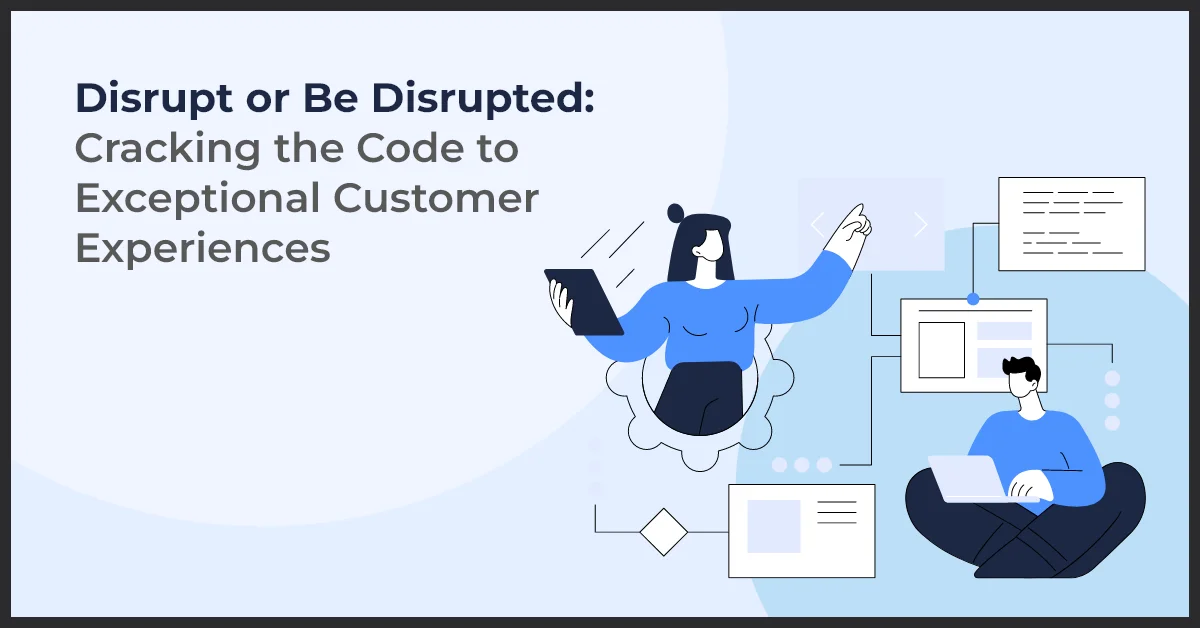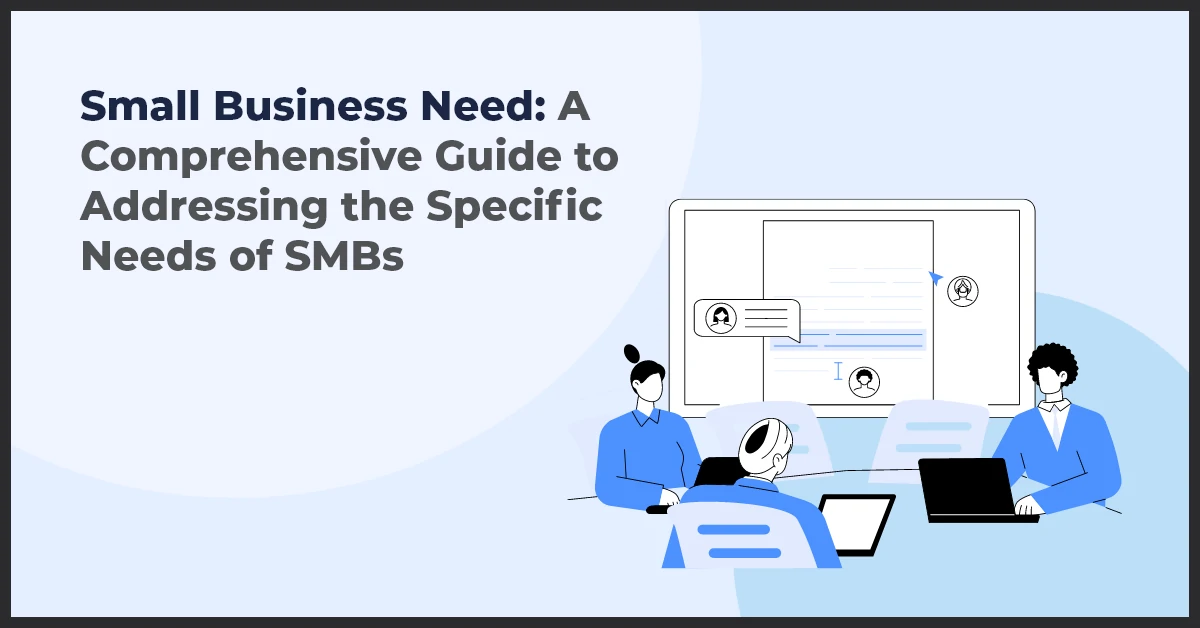Disrupt or Be Disrupted: Cracking the Code to Exceptional Customer Experiences

Published on: May 17, 2023
Updated on: June 28, 2024
2384 Views
- Business
19 min read
Delivering excellent client experiences is no longer a luxury in today's brutally competitive business environment; it's a strategic need that can differentiate your company. Customer experience is a transforming journey that enthralls and satisfies customers at every touchpoint rather than merely being a transactional procedure. It's about producing wonderful experiences that endure long after the sale has been completed. By putting the customer experience at the center of your company, you can build strong relationships, encourage loyalty, and promote long-term expansion.
The client journey itself is at the center of this journey. It is the journey that your clients take, one that includes their feelings, wants, and encounters with your business. You can fine-tune each touchpoint and produce life-changing experiences by methodically mapping the customer journey. This gives you unique insights into the critical moments that determine the course of the client's experience.
The quest for superior customer experience, however, goes beyond just outlining the route. It also includes a steadfast dedication to measurement and ongoing development. You can take your customer experience to new heights by continually optimizing your procedures, utilizing the power of data, and paying attention to the opinions of your customers.
Get ready to start the revolution in customer experience and redefine what is possible. In our following segment, let's start by delving deeply into the customer journey and mapping amazing experiences.
Understanding the Customer Journey
The Customer Journey: Navigating Touchpoints With Your Brand
When customers interact with your brand, they travel a dynamic route known as the customer journey. From the initial point of contact through the very end of their connection with your business, every encounter is covered. Consider it as a collection of touchpoints that work together to shape the entire consumer experience.
Customers generate perceptions, feelings, and judgments about your brand at each touchpoint. These touchpoints can involve visiting your website, reading reviews, getting in touch with customer care, buying something, getting help, and even telling others about their experiences. Each encounter affects how they see your brand overall and whether they want to stay involved or not.

The Power of Mapping the Customer Journey
A strategic exercise that can help you comprehend and picture the full experience from the viewpoint of the consumer is mapping the customer journey. You can learn a lot about the motives, expectations, and pain points of the client by visualizing their journey.
You can proactively address and fix problems that can impede the consumer experience by identifying pain spots. You can generate moments of joy and surpass client expectations by concentrating on possibilities. A consistent and smooth experience across channels is ensured through trip mapping, which helps you to coordinate your efforts and resources to improve each touchpoint.
Enhancing Customer Experience
Practical Tips for Improving Customer Experience in Different Contexts
Call Centers: Empowering Meaningful Connections
Reduce Wait Times
Utilize technology and effective call routing systems to reduce hold times and guarantee that consumers are quickly connected to the appropriate staff. Call analytics can be used to locate bottlenecks and improve call flow.
Train Customer Service Representatives
Offer thorough training programs to give reps an understanding of the products, problem-solving abilities, and communication skills. To establish trust and connection with clients, promote active listening, empathy, and patience.
Foster Empathetic Communication
Encourage employees to put themselves in the customers' position, pay close attention to their issues, and respond to them with empathy and understanding to promote empathic communication. Give them the tools they need to go above and beyond by providing individualized solutions and going above and beyond to satisfy customers.
Retail Stores: Crafting Memorable In-Person Experiences
Create A Welcoming Ambiance
Create a welcoming atmosphere by designing the store layout with eye-catching displays that emphasize items and foster a friendly environment. Make sure the aisles are clean, well-lit, and simple to use so that customers can browse without getting lost.
Offer Personalized Recommendations
Provide customized suggestions based on consumer preferences, past purchases, and browsing patterns by utilizing customer data, loyalty programs, and digital technologies. Teach sales representatives how to have thoughtful discussions with customers and provide individualized product recommendations that satisfy their needs.
Streamline the Checkout Process
Streamline the checkout procedure by putting in place effective point-of-sale solutions that cut down on wait times. Offer a variety of payment choices, such as contactless and mobile payment options, to accommodate different client preferences and offer a simple and straightforward checkout process.
Banking: Elevating Digital Experiences with a Personal Touch
Seamless Digital Experiences
Invest in user-friendly online and mobile platforms that let users easily access and manage their accounts, complete purchases, and get help. This will create seamless digital experiences for your customers. To empower clients in their digital banking experiences, offer easy navigation, secure authentication procedures, and self-service capabilities.
Personalized Financial Advice
Utilize data analytics and customer insights to provide individualized financial counsel and suggestions. Individual financial goals and risk profiles should be taken into account when developing product offers, savings alternatives, and investment strategies. Use chatbots or virtual assistants with AI to offer in-the-moment financial advice and assistance.
Proactive Fraud Prevention
Put strong security measures in place to safeguard client accounts and data. Inform clients proactively about fraud threats, safe browsing habits, and the security measures your company has in place to protect their financial data. Assist clients in staying cautious against possible fraud attempts by providing them with educational materials and timely notifications.
Showcasing Examples of Exceptional Customer Experience Companies
Zappos
Zappos is an online retailer of shoes and apparel that has earned a remarkable reputation for its customer-focused philosophy. They put the needs of the consumer first and go above and beyond to make sure they have a great experience. Zappos is renowned for its 365-day return period, free shipping and returns, and round-the-clock customer assistance. Their customer service personnel are given the freedom to address problems and build individualized relationships with clients, promoting loyalty and trust.
Ritz-Carlton
The Ritz-Carlton hotel brand is known for its opulence and unsurpassed customer service. They have established standards for distinctive hospitality encounters. Every employee at Ritz-Carlton is given the freedom to anticipate and surpass client expectations. Their "Gold Standards" serve as a set of guiding principles, placing an emphasis on personalization, warmth, and attention to detail. The business is renowned for its illustrious customer service and dedication to providing visitors with special experiences.
Amazon
Amazon, one of the biggest e-commerce sites in the world, has transformed the consumer experience via ease, customization, and quick delivery. They excel in using data analytics and AI algorithms to provide pertinent product recommendations and provide a frictionless shopping experience. One-click buying, simple returns, and proactive customer service are just a few of the aspects that make up Amazon's customer-focused strategy. They have developed into a world leader in online shopping thanks to their commitment to innovation and consumer happiness.
Measuring and Managing Customer Experience
The Importance of Measuring Customer Experience
Identifying Areas For Improvement
Measuring customer experience enables firms to identify problem areas, bottlenecks, and places where customers' expectations are not being fulfilled. Effective resource allocation and improvement prioritization are made possible by this information.
Tracking Progress and Trends
Measuring customer experience metrics consistently allows firms to monitor their performance over time and spot patterns. This makes it possible for them to spot patterns, evaluate the effects of projects or adjustments, and make sure that advancements are being achieved.
Aligning With Customer Expectations
Analyzing customer experience offers insightful information about how well a company is doing in this regard. It assists in identifying discrepancies between consumer expectations and the actual experience, enabling businesses to make necessary adjustments and provide experiences that are in line with the demands and preferences of their customers.
Key Metrics and Methods for Measuring Customer Experience
Net Promoter Score (NPS)
NPS gauges client loyalty and propensity to refer a company to others. On a scale of 0 to 10, customers are asked to assess their probability. Customers are divided into Promoters (scores 9–10), Passives (scores 7-8), or Detractors (scores 0-6) according to the NPS. NPS is a straightforward, single-number indicator that measures general customer satisfaction.
Customer Satisfaction (CSAT) Surveys

Customers' satisfaction with certain interactions or experiences is measured through CSAT surveys. On a scale, usually from 1 to 5 or 1 to 10, customers are asked to assess how satisfied they are. CSAT surveys assist in identifying certain touchpoints or regions that need development.
Qualitative Feedback
Open-ended inquiries, in-person conversations with clients, and social media monitoring all yield significant insights into client opinions, preferences, and problem areas. This input enhances quantitative measures and aids in identifying the underlying causes of consumer impressions.
Customer Effort Score (CES)
CES evaluates how simple or challenging a customer experience is. Customers are questioned about how much work they think it takes to perform a certain job or engagement. Lower effort scores denote a more effortless and enjoyable experience.
The Role of Customer Experience Management (CEM)
Comprehensive View of the Customer Journey
Businesses can adopt a comprehensive approach to the customer journey with CEM by taking into account all touchpoints and interactions. Businesses can pinpoint consumer pain spots, growth opportunities, and delightful moments by charting the customer journey and comprehending each stage. This all-encompassing viewpoint enables focused improvements and a more seamless and positive client experience.
Consistency and Alignment
CEM guarantees consistency and alignment between customer experiences and the brand's values, promises, and desired results. Creating a cohesive experience across channels and divisions entails defining precise rules, standards, and processes. Consistency improves the perception of the brand as a whole, promotes brand loyalty, and generates trust.
Continuous Improvement
A continuous process of measurement, analysis, and improvement is part of CEM. Businesses can discover areas for improvement and implement incremental adjustments to steadily increase the customer experience by gathering and evaluating consumer input, measuring metrics, and tracking performance. CEM enables organizations to remain adaptable and responsive to changing consumer demands.
Employee Engagement
Delivering excellent customer experiences depends on having engaged and empowered workers. CEM is promoting a customer-centric culture and giving staff members the resources, instruction, and freedom they need to provide exceptional customer service. Employees who are motivated and aware of how they contribute to the customer experience are more inclined to go above and beyond and build enduring relationships.
Personalizing the Customer Experience
The Significance of Personalization in Creating Memorable Experiences
Enhanced Customer Engagement

Beyond standard encounters, personalization gives clients a sense of worth and comprehension. Businesses can build tailored experiences that appeal to specific consumers when they take the effort to learn the interests, habits, and demands of their customers. Customers get more emotionally connected to the company thanks to this level of customization, increasing brand engagement.
Personalization fosters a feeling of relevance and strengthens bonds between consumers and businesses, whether it takes the form of addressing clients by name, making tailored suggestions, or supplying niche content.
Improved Customer Satisfaction
Businesses can create experiences that match client preferences and demands thanks to personalization. Businesses can adjust their services to match particular requirements, offer pertinent solutions, and anticipate client demands by knowing unique customer profiles.
By removing extraneous information and recommendations, this level of customization improves customer happiness while also saving consumers time and effort in order to get what they're searching for. Customers are more satisfied and more likely to remain loyal to a business when they believe that it recognizes and caters to their specific interests.
Increased Sales and Conversions
Conversion rates and revenues are directly impacted by personalized experiences. Customers are more likely to find value in recommendations, deals, or product ideas that are made just for them. Customers can find products and services that suit their interests and requirements thanks to personalization, which also gives them a sense of relevance.
Higher conversion rates are achieved as a result of the targeted approach's increased likelihood to convert clients into buyers. Additionally, as customers are more inclined to stick with a business that regularly provides individualized experiences, personalized experiences also promote repeat purchases and customer loyalty.
Examples of Companies Excelling in Personalization
Netflix
Netflix's use of advanced recommendation algorithms has transformed the way we consume content. Netflix offers individualized movie and TV program suggestions based on customer watching habits, tastes, and ratings. This degree of customization not only improves the user experience but also keeps users interested and returning.
Spotify
With its curated playlists and Discover Weekly feature, the well-known music streaming service Spotify excels at personalization. Spotify makes tailored playlists that suit users' musical interests using a mix of listening history, genre preferences, and music trends. This tailored approach improves user experience and maintains consumers' interest in the site.
Amazon

Amazon is well known for offering highly customized purchasing experiences. Amazon provides customized product suggestions, specialized search results, and targeted marketing efforts by examining customers' browsing histories, purchasing patterns, and demographic data. Customers benefit from a smooth and practical shopping experience because of this degree of personalization.
Unlocking Personalization Power: Strategies to Delight Customers on a Personal Level
Personalized Product Recommendations
Offering product suggestions based on consumer preferences and behaviors is one of the most popular and successful personalization techniques. Businesses can provide pertinent product or service recommendations that fit each customer's preferences by looking at their purchase history, browsing habits, and demographic data.
Customers can have a curated purchasing experience and learn about new goods they might be interested in by seeing personalized recommendations on websites, via email campaigns, or inside mobile applications.
Customized Messaging
Customizing messages to each individual customer's unique demands or interests is known as personalized messaging. This approach includes customized marketing efforts, dynamic website content, and personalized email marketing. Businesses can develop extremely relevant and compelling marketing by segmenting clients based on demographics, previous interactions, or purchase history.
The customer experience can be greatly improved by, for instance, using customers' names when sending emails, catering material to their tastes, or delivering offers that are specifically tailored to them based on previous purchases.
Targeted Offers and Promotions
Customers' engagement and conversions can be dramatically impacted by tailoring offers and promotions based on their data and habits. Businesses can use customer segmentation to pinpoint particular demographics or individuals who could be interested in a particular range of goods or services.
Businesses can increase the possibility of conversion and repeat business by customizing offers, discounts, or prizes in accordance with client preferences or previous purchases.
Location-Based Personalization
A customer's geographic location is used by location-based personalization to deliver tailored and regionally relevant information or offers. Businesses can notify clients about local establishments, activities, or specials by utilizing geolocation technology.
For instance, a retail app can notify users through push notifications when they are close to a real store, providing them tailored discounts or bringing to the attention products they have previously expressed interest in. By providing timely and location-specific information, this tactic improves the consumer experience.
Personalized Content and Experiences
Businesses can tailor content and experiences across a variety of media to suit the tastes of certain customers. This involves delivering customized user interfaces through mobile apps, recommending pertinent blog posts or articles, and personalizing website interfaces.
Businesses can provide a more engaging and immersive experience, extending users' stay on their platforms, and fostering deeper interaction by personalizing content to each customer's interests.
Designing Memorable Customer Experiences
Introducing Customer Experience Design: Crafting Experiences that Captivate and Delight
Designing memorable client experiences has become a strategic priority for organizations in today's customer-centric environment. The deliberate design of interactions, touchpoints, and journeys that satisfy customers' demands while simultaneously inspiring a positive emotional response is known as customer experience design. It involves going beyond basic functioning and producing moments that have an effect. Here are some steps firms can take to start the customer experience design process.
Practical Steps to Designing Memorable Customer Experiences
Customer Research
Outstanding experience design starts with a thorough understanding of your target audience. To learn more about your customers' interests, behaviors, pain spots, and objectives, conduct detailed customer research. Use data analysis, questionnaires, and interviews to collect qualitative and quantitative information that will help the design process.
Empathy Mapping
Create empathy maps and put yourself in your consumers' position to increase your empathy. You can better comprehend consumers' ideas, feelings, demands, and issues at each touchpoint with the aid of these graphic representations. Empathy mapping offers useful insights for creating experiences that emotionally connect with clients.
Ideation
Generate ideas that solve the wants and problems of the customers that have been identified. Promote cross-functional cooperation and make use of various viewpoints to produce a variety of inventive solutions. Encourage an atmosphere where no concept is too outlandish or unusual during this ideation period.
Prototyping
By building prototypes, you can turn your ideas into actual objects. Depending on how complicated the experience is, prototypes can be either low-fidelity or high-fidelity. They provide fast testing and iteration, allowing you to get feedback and improve the design prior to spending a lot of money on execution.
Testing
Test the prototypes with actual customers to verify the design hypotheses. do usability testing, collect consumer feedback, and see how they interact. Utilize this input to improve the design and make it more customer-friendly so that it provides a seamless experience.
Inspiring Examples of Design-Driven Customer Experiences
Apple
Apple, recognized for its sleek and user-friendly products, has become a global leader in experiences that emphasize design. Apple's commitment to elegant design is evident at every touchpoint with its products, from the simple-to-use user interface to the high-quality packaging.
The emphasis on simplicity, care for the little things, and user-centered design have earned the brand a loyal fanbase. By creating products that are both aesthetically beautiful and easy to use, Apple has enhanced the entire customer experience.
Airbnb
The travel and hospitality sector disruptor Airbnb has completely changed how customers experience lodging. Airbnb's dedication to design, which results in aesthetically attractive and engaging experiences for both hosts and guests, is essential to the company's success.
Every encounter with Airbnb is easy and motivating because of the user-friendly website and mobile app interfaces as well as the professionally chosen property listings. Airbnb has improved the booking and stay experiences by fusing lovely graphics, transparent communication, and personalization, encouraging a sense of connection and adventure for their consumers.
These businesses provide examples of the benefits of customer experiences driven by design. They have created memorable and engaging experiences that connect with customers on both a functional and emotional level by incorporating design concepts into their offerings in terms of goods, services, and touchpoints. These examples encourage companies to emphasize design thinking and take the complete client experience into account.
Customer Experience Success Stories: Inspiring Tales of Exceptional Experiences
Unveiling Inspiring Customer Experience Success Stories
Starbucks
Starbucks is renowned for its dedication to offering a distinctive and friendly customer experience. Customers can place orders and make payments in advance using their smartphone app, making for a simple and quick process. Additionally, Starbucks values consumer feedback and updates its product lineup frequently to reflect customer preferences. This commitment to providing individualized care has raised brand advocacy and client loyalty.
LEGO
By embracing user-generated content and building a feeling of community, LEGO has successfully altered its consumer experience. Customers can submit their own designs using their online platform, LEGO Ideas, which can subsequently be made into official LEGO kits. LEGO has expanded consumer interaction and created a devoted brand community by including its ardent fan base in the product production process.
Patagonia
Outdoor clothing company Patagonia is well known for its dedication to sustainability and social responsibility. By providing repair services for their products, encouraging recycling programs, and openly disclosing information about their supply chain, they have weaved their ideals into the consumer experience. Customers have responded favorably to this honesty and commitment to environmental and social problems, which has strengthened brand loyalty and improved brand reputation.
The Impact of Customer Experience Success Stories
Customer Loyalty
By placing a high priority on customer-centric methods, these businesses have developed enduring emotional bonds with their clients. This connection on an emotional level increases consumer loyalty, which promotes return business, word-of-mouth referrals, and long-term connections.
Brand Reputation
Outstanding customer experiences have a significant impact on a brand's reputation. Customers develop trust, credibility, and favorable perception of a brand when they connect with it in a positive way and remember it. This further increases the brand's standing in the market and draws in new clients.
Business Growth
Success stories in customer experiences and business growth are frequently correlated. Customers that are happy and loyal are more likely to become brand ambassadors and spread the word about the business to their networks. Positive word-of-mouth propagates revenue growth and long-term business success along with improved client retention.
Conclusion
Delivering excellent client experiences is the secret to standing out in today's brutally competitive business environment. It is a strategic need, not merely a pleasure to have. We've identified effective tactics and best practices for improving customer experiences in this blog. It's time to go forward and develop your company.
Don't settle for mediocrity. To reinvent your customer service, customize experiences, and map the customer journey, put the ideas and advice given here to use.
Keep yourself educated and motivated to remain at the forefront of customer experience innovation. To receive frequent updates, insights, and market-leading tactics, sign up for our newsletter. Contact us at info@growthnatives.com or +1 855-693-4769 to learn more about how our knowledgeable staff can assist you in improving your customer experience journey.
Sources:



